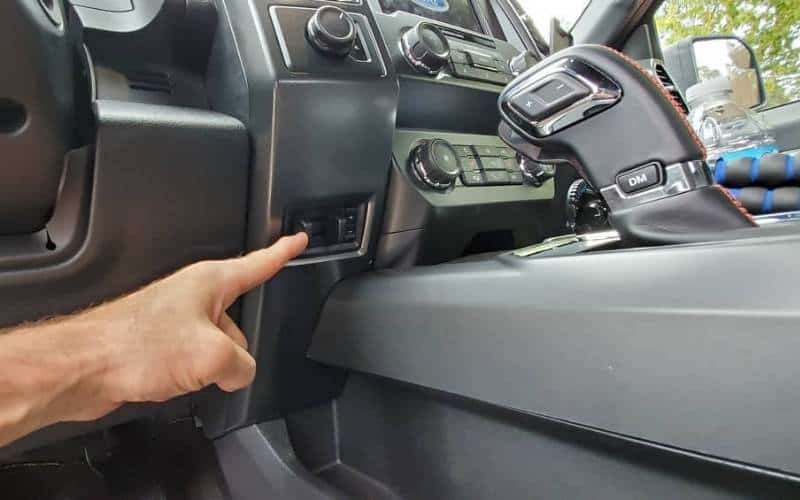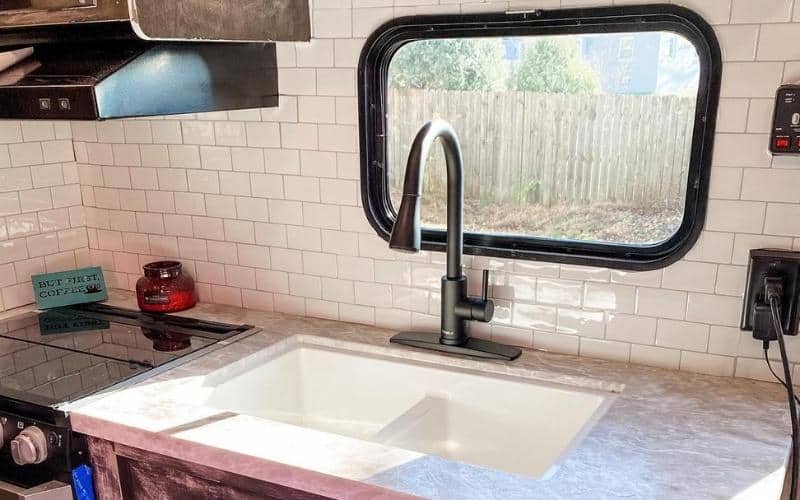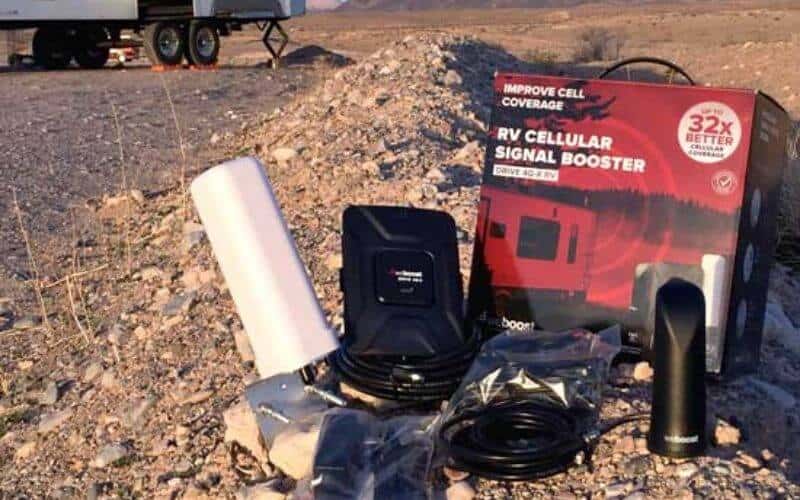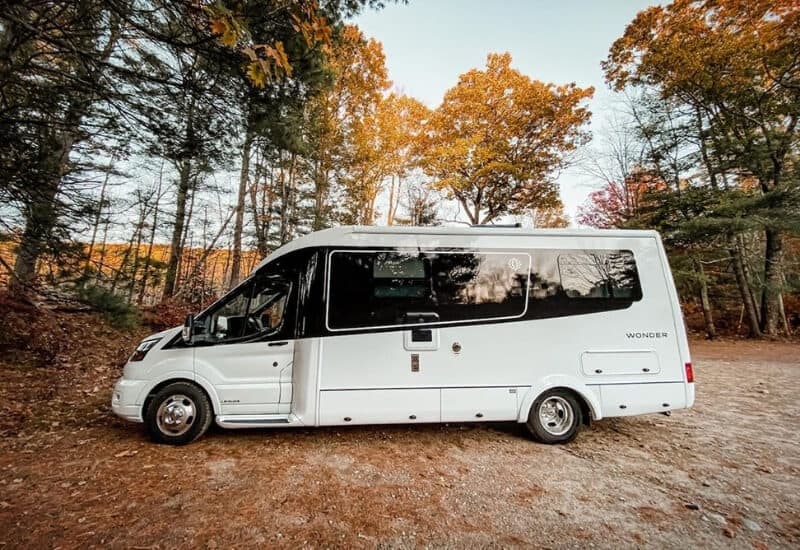Do you know that sickening smell of your brakes burning up on a steep downgrade all too well?
Towing a trailer puts added strain on all the parts of your vehicle. None, arguably, bear quite as much responsibility for your health (and the health of your trailer) as your brakes.
Before trailer brakes were invented, all of the responsibility for stopping your vehicle and your trailer was placed solely on your vehicle’s brake pads and rotors.
Nowadays, most travel trailers have electric brakes that assist in slowing everything down.
But your vehicle and your trailer must communicate effectively for everything to do its job properly. That is where a trailer brake controller comes into play.
If your tow vehicle doesn’t already have a brake controller, installing an electric brake controller is key to safe towing a heavy trailer with your pickup truck or SUV.
But when it’s come to choosing the best trailer brake controller for your vehicle, there are several factors to consider.
In order to help you choose the model that is best suited to your specific setup, we are going to review 5 options if you need a new trailer brake controller for towing a travel trailer or fifth wheel camper.
But first, let’s talk a little more about what these controllers are, how they work, and whether or not you really need one!
What Is a Trailer Brake Controller?
A trailer brake controller is an electronic gadget that controls the electric brakes on your trailer. It installs in the cab of your vehicle and most people mount it to the dashboard slightly underneath and to the right of the steering wheel.
It helps to have it in reach while driving so that you can activate it and adjust certain settings.
A brake controller also allows you to monitor your trailer’s electric brakes to make sure they are functioning properly.
Most brake controllers come with several different settings that allow you to adjust output and set a threshold for automatic activation of your trailer brakes. Many also allow you to activate your trailer brakes manually.
How Do Trailer Brake Controllers Work?
In order to get a better understanding of how trailer brake controllers work, you need to understand that there are two main types: proportional controllers versus time-delayed controllers.
How Proportional Brake Controllers Work
Proportional (or inertia-based) trailer brake controllers are built with an electrical circuit known as an accelerometer. This accelerometer detects changes in your vehicle’s momentum.
By doing so, the controller is able to apply power to your trailer brakes that is proportional to the change in momentum sensed in your tow vehicle.
This happens when you apply the brakes in your vehicle and the controller picks up on the change in momentum that occurs as a result.
These trailer brake controllers are very precise and they provide smooth stopping on all types of terrain.
For instance, a proportional controller will automatically less power if you are braking on an incline and more power if you are braking on a decline.
How Time-Delayed Trailer Brake Controllers Work
A time-delayed trailer brake controller works using the electrical principle known as gain.
When you apply pressure to your brake pedal, a time-delayed controller applies power to your trailer’s electric brakes.
Slowly, the controller increases the amount of power applied on a fixed basis according to a certain metric of time.
As an operator, it is up to you to adjust the gain setting on your controller according to your specific trailer’s needs.
As you can imagine, this type of controller is less precise than an inertia-based (proportional) trailer brake controller.
If not set properly, it can also lead to more abrupt stopping than one might prefer.
Do I Even Need a Trailer Brake Controller?
There are both legal and practical reasons to get a trailer brake controller.
For starters, some states require that you have one if your trailer weighs more than 3,000 pounds or more than 40% of your tow vehicle’s total weight.
In addition, it is wise to have a controller if your trailer has electric brakes (or what are known as “electric over hydraulic” brakes).
In fact, both of these types of brakes will not work without a brake controller.
The good news is that most newer trucks that are designed for towing larger trailers come with factory-installed brake controllers.
They are built right into the vehicle and if you already have one, there is no need to install one of these aftermarket brake controllers.
Some trailers are also equipped with surge brakes. This is a hydraulic braking system in which the brakes are activated due to the trailer’s weight and momentum.
Trailers with surge brakes don’t require the use of a trailer brake controller.
If you plan to tow with a larger SUV or passenger vehicle, however, you should first double-check your vehicle’s tow ratings and then look into the right trailer brake controller to install.
If your trailer doesn’t have electric brakes, there is no need for a trailer brake controller.
5 Best Electric Brake Controllers For Towing Trailers Safely
If you answered yes to most of the questions in the previous section, you need a trailer brake controller.
So let’s dive into the details of five best electric trailer brake controller on the market today.
1: Best Overall: CURT 51180 Bluetooth-Enabled Electric Trailer Brake Controller
Controller Type: Proportional
The cool part about this electric brake controller is that it uses Bluetooth to connect to your smartphone. So you won’t have to install an interface in the cab of your vehicle and running wiring between it and the connector next to your trailer hitch.
Yes, you heard that correctly. That means easier installation because you won’t have to run wiring the length of your vehicle. Simply plug in the 7-way trailer wiring connector under your rear bumper and you are ready to go.
Now, here is one thing that concerned me when I first saw this wireless brake controller: what happens if the connection between the controller and your smartphone is lost?
I have Bluetooth headphones and sometimes they will disconnect from my phone or computer seemingly at random.
Fortunately, this portable brake controller will continue to function based on the most recently programmed settings if the connection with your smartphone is lost for any reason.
Of course, you can only make adjustments while stationary with this controller because you will need to download CURT’s dedicated app to do so. And we advise avoiding distracted driving by keeping your smartphone out of your hands and your eyes on the road!
This controller will work on single-axle or dual-axle trailers. Internally, it utilizes a triple-axis accelerometer to provide safe, consistent braking action.
It is also compatible with cruise control, vehicles with anti-lock brakes, and low-voltage systems.
If you have multiple vehicles that you use to tow your trailer (or multiple trailers for that matter), this is one of the best options because it can be moved from vehicle to vehicle in seconds.
It also allows you to save multiple user or vehicle profiles on the smartphone app so that you have the right settings ready to go at the push of a button.
Things We Like
2: Best For Heavy Loads: Tuson RV DirecLink Brake Controller
Controller Type: Proportional
The DirecLink Brake Controller is actually made by Tuson RV Brakes, LLC. In many ways, this model is the exact opposite of the CURT model above because everything gets hard-wired into your vehicle.
This proportional trailer brake controller, however, provides some of the most complete brake diagnostic information of any controller on the market.
It connects to your vehicle’s OBDII port to provide critical information about your vehicle and trailer brakes.
Of course, the ability to interpret and analyze that information is going to depend on your skills and experience.
If you know what you are looking for and you do quite a bit of towing heavy loads, this controller is a great option.
This is the DL-100 model from Tuson RV Brakes and it is compatible with all Ford and GM vehicles from 1997 to present and all Chrysler vehicles from 2004 to present (although some Dodge models from 2005 to 2007 may experience intermittent OBD connection issues).
It also works with Toyota, Nissan, Mercedes Benz, Volkswagen, BMW, Land Rover, and Porsche models from 2008 to present.
One issue that some people experience with their brake controller is the difficulty of finding a gain setting that works at all speeds.
In many cases, the setting that works best for driving at highway speeds might cause your brakes to lock up unnecessarily when driving at slower speeds.
That is why this controller includes a low-speed brake adjustment. Essentially, it allows you to program two separate gain settings for highway driving and in-town cruising.
This reduces brake lockup and the need to make gain adjustments while you are driving.
Things We Like
3: Best with Boost Feature: Tekonsha 90160 Primus IQ Brake Control
Controller Type: Proportional
This proportional trailer brake controller is equipped with a boost feature that allows you to increase the initial braking power when towing a larger trailer.
To that end, it is compatible with single-axle, dual-axle, and three-axle trailers.
You will need to hardwire in the plug for this controller in the installation phase, but it does include a removable electrical connector for easy removal if you do need to take it out of your vehicle.
It works with only electric trailer brakes only (not electric-over-hydraulic) but also operates proportionally in reverse.
So you will have an easier time backing your larger trailer into tight spots and enjoy more precise braking control when doing so.
In terms of the display, the digital LED readout perpetually displays your personalized gain setting.
If any diagnostic issues do arise, however, the display updates to keep you informed.
That includes information on the amount of voltage being delivered to your trailer brakes and verification of a secure electrical connection.
Things We Like
4: Best Budget: Reese Towpower 8508211Proportional Brake Control
Controller Type: Proportional
This proportional brake controller is one of the most affordable models we could find. It still includes many useful features for safe towing of larger loads and it is designed to be compatible with trailers with 1-4 axles.
This self-leveling controller and it works proportionally in reverse as well as when driving forward.
The large LED display on this model makes it easy to double-check your gain setting and make adjustments on the fly.
That LED display also has integrated diagnostics features to help you monitor your tow vehicle and trailer brakes.
The unit also features reverse battery protection to ensure a safer, more reliable electrical connection over the life of the controller.
Even though it doesn’t feature Bluetooth technology like the CURT model, it does come with a plug-and-play connector.
You will need the proper factory harness to make this unit compatible with your vehicle though, so make sure to double-check the fit.
Things We Like
5: Best with Dynamic Display: CURT 51160 Assure Electric Trailer Brake Controller
Controller Type: Proportional
The last trailer brake controller that I want to highlight is CURT’s Assure model.
It doesn’t boast the smartphone compatibility of the Echo Mobile model, but it does have a more dynamic display than all of the other controllers you have seen above.
The display is 1.5 inches wide and pivots to different angles for better visibility. It also displays full-text messages in a bright, easy-to-read format.
Functionally, this means you don’t have to interpret what your brake controller display is trying to tell you when you look down at it.
Experienced drivers will love the precise manual override button on this controller.
The button is pressure-sensitive to help you apply precise braking power manually, which can be useful on steep hills or for reducing trailer sway.
You will also have the freedom to install the display at various angles so that it is easy to see from your driving position.
Once installed, it will automatically level and calibrate, which makes setting it up quick and easy.
It also features nine different sensitivity level settings and a sleep mode to help prevent battery drain.
It can work with trailers with 1-4 axles and provides diagnostic alerts (low voltage, battery disconnect, etc.) as well as controlling trailer brake function.
Things We Like
How to Choose a Trailer Brake Controller
So now you need to know how your vehicle and your trailer impact your choice. Let’s discuss some tips for choosing the right trailer brake controller for your specific scenario.
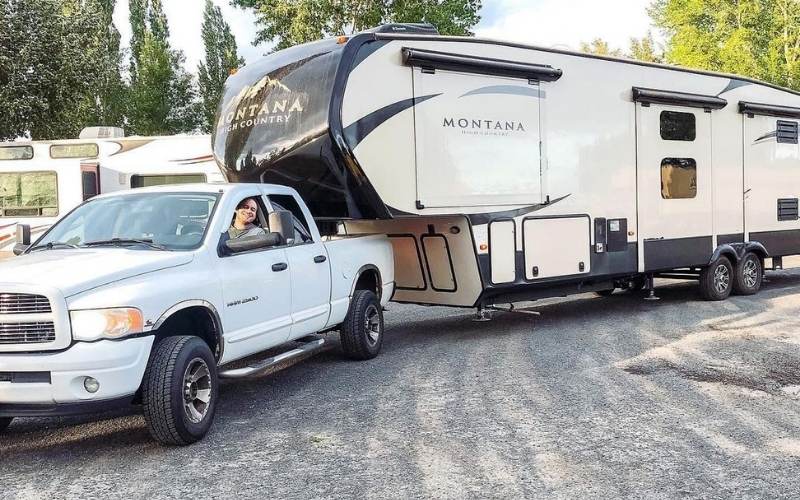
Type of Brakes on Your Trailer
The first thing that you need to learn is the type of brakes on your trailer. Most modern trailers have electric brakes, but check your owner’s manual to learn if you are working with electric, electric-over-hydraulic, or surge brakes on your trailer.
The type of brakes on your trailer is going to help you find a compatible brake controller (if you need one at all).
Trailers with electric or electric-over-hydraulic brakes require a brake controller in the cab of your vehicle. Trailers with surge brakes do not.
Your Tow Vehicle
Next, check under the dash of your tow vehicle to see if you already have a factory-installed brake controller.
If you do, you may not need to worry about upgrading, although it can be helpful if you are towing a large trailer.
You will also need to locate and write down the year, make, and model of your tow vehicle for later use.
Before buying a trailer brake controller, input that information on the manufacturer’s fit guide to make sure it is compatible with your vehicle.
Trailer Size and Weight
The length and loaded weight of your trailer are also important to keep in mind when selecting your brake controller.
Not all models are designed to apply power to brakes on a triple-axle trailer, for example.
To that end, the number of axles on your trailer is actually more important than the total length. But longer trailers also tend to have more axles and shorter trailers have fewer.
Single-axle trailers have two brakes, double-axle trailers have four, and so on and so forth (up to quad-axles with 8 brakes).
Additionally, check your owner’s manual for the unloaded vehicle weight (or dry weight) of your trailer.
That is the original weight before you have added any gear or made any structural changes to your trailer.
In most cases, it is a safe bet to estimate adding anywhere from 500 to 1,000 pounds to your unloaded trailer weight.
Depending on how much food, heavy appliances, and recreation gear you load into your trailer, those numbers could actually be on the low end.
The main thing to pay attention to here is to choose a controller that is compatible with the number of axles on your trailer.
But knowing the loaded weight of your trailer will also help you find a controller that can handle heavier loads if you have a larger trailer.
Tow Frequency
Also, consider how much towing you plan on doing. If you live in your trailer full-time and relocate often, it pays to spend a little more on a high-quality proportional controller.
These are also the best types of brake controllers for towing work trailers, commercial cargo, livestock, and other heavier loads.
If you have a small popup camper, however, you can choose a more budget-friendly time-delayed controller.
This type of brake controller is also best if you only travel in your trailer a couple of times a year.
That said, proportional brake controllers will work just fine with smaller campers and for less frequent towing.
Although they tend to be slightly more expensive, they are the most reliable and responsive braking assistance system you could install.
Installation and User Interface
Most of these brake controllers require a very simple wiring process that you can complete at home.
If you have a local mechanic you trust, there is also a chance he or she will install the brake controller for you if you request such a service.
However, you probably noticed that our Best Overall choice offered Bluetooth connectivity.
That particular model is going to have a much simpler installation process than the rest because it doesn’t require any wiring at all.
You will actually just replace the 7-way electrical connector currently on your tow vehicle with the one from CURT.
If you prefer using your smartphone as the interface for adjusting your brake controller, that is going to be your best option.
For those of you that would rather not use your smartphone while driving, look for a model with a clear and adjustable digital LED display and push-button interface.
How to Adjust a Trailer Brake Controller
“A hammer is only as good as the person swinging it.” – Every construction worker ever
Installing a trailer brake controller is just the first step. You will also need to adjust it properly according to your trailer-vehicle combination. So let’s go over some adjustment tips and strategies.
Hook Trailer Up to Vehicle Hitch
The first step to adjusting your trailer brake controller is to connect your trailer to your tow vehicle.
Make sure your hitch receiver has the pin installed and your trailer coupler is secured to the hitch ball.
Plug In Your Trailer Wiring Harness
Next, plug in the wiring harness from your trailer to your vehicle’s wiring outlet.
You need to have power connected to your brake controller and a secure connection to your trailer’s electric brakes to function properly.
To prepare for this step (and the next few) make sure you park your vehicle and trailer on a level surface.
It will also be helpful to have some flat, uncrowded road in front of your vehicle to give you plenty of stopping distance to double-check your controller’s function.
Calibrate Your Trailer Brake Controller
Once your trailer is plugged in, your controller should automatically begin to calibrate.
Most models have some sort of flashing or blinking light on the display that tells you the calibration process is ongoing.
A different signal should indicate that the calibration is complete. Just keep in mind that some brake controllers actually do not require calibration at all, so consult the owner’s manual to see if yours does.
Choose Your User Settings
Once your controller is calibrated (if it is needed), you can select your personal settings.
Gain is the main setting that you want to dial in so that the controller applies the appropriate amount of braking power to your trailer brakes (more on that in the next section).
Most units also have user settings that pertain more to ease of use. That includes things like the angle of the interface and the brightness of the LED display.
Select Maximum Output
You will now need to set the maximum output for your controller. This setting is synonymous with gain and it dictates the maximum amount of power that the controller will apply to your trailer brakes.
You can set maximum output initially according to the recommendations of your specific controller.
From there, you will likely need to make minor adjustments according to the load size of your trailer.
To set your output, press and hold the brake pedal and then program the starting value specified in your controller’s instructions.
Make sure you have plenty of open road in front of you and then test your system by accelerating to about 25 miles per hour and applying your brakes.
If you feel like your vehicle stops too slowly, you can increase the maximum output. If it stops abruptly or locks up entirely, slightly decrease your maximum output setting.
Adjust Sensitivity Level
You will need to do one more test to set the sensitivity of your controller. Sensitivity is the aggression with which your controller applies the brakes.
Once again, accelerate to about 25 miles per hour and apply pressure to the brake pedal. Increase the sensitivity setting if your vehicle stops too slowly and decrease it if it stops too abruptly.
As you gain comfort with how your controller works and how to control it, you can perform this test again at various different driving speeds.
This will allow you to dial in your controller’s sensitivity so that it delivers smooth stops at all speeds.
Utilize Manual Activation As Needed
Even once you have your settings dialed in, most controllers will still allow you to activate them manually as needed.
This is done by hand instead of by applying pressure to your brake pedal with your foot.
Most experienced drivers will use manual activation strategically to correct minor trailer sway and to begin stopping early when a red light is evident far in the distance.
It can also be useful for minimizing wear on your vehicle’s brakes on long, steep downgrades.
Frequently Asked Questions
I don’t know about you, but lots of questions always come up for me when I am thinking about adding a new electronic appliance or device to my truck.
So it makes sense to me to overturn a few more stones here by answering a few of the most frequently asked questions about these trailer brake controllers.
How do you calibrate a trailer brake controller?
To adjust electric brake controller, park your vehicle on a level surface and plug your trailer into your vehicle. The controller will automatically calibrate itself, although some minor adjustments may be required based on vehicle tow capacity, trailer size, and total loaded weight.
What is trailer gain?
Gain refers to the amount of power a brake controller applies to your trailer’s electric brakes. It should be equal to the maximum stopping force for your trailer.
As you press down on your tow vehicle’s brake pedal, the gain setting on your controller regulates the amount of electrical power applied to the electromagnets on your trailer brakes.
What should my trailer gain be set at?
The right gain setting for your brake controller depends on trailer size and loaded weight. Larger trailers require a higher gain setting while smaller trailers need a lower gain setting to prevent the brakes from locking up.
What is the best setting for my trailer brake controller?
Dialing in the best setting for your trailer brake controller requires a bit of adjustment.
Fortunately, most brake controllers will come with manufacturer recommendations for settings that will match the size and weight of your trailer.
Start by following the manufacturer’s recommendations that match up with your trailer.
From there, you can make small adjustments (up or down) if you require more gain or sensitivity.
Conclusion
At the end of the day, a trailer brake controller is a small investment that goes towards protecting your larger investments (aka your trailer and tow vehicle).
It will also help you avoid running through brake pads and rotors too quickly.
If your vehicle did not come with a factory-installed trailer brake controller, we highly recommend one of the aftermarket models that we highlighted above.
Just take the time to make sure the model you choose is compatible with the year, make, and model of your vehicle.
As always, we hope that you have gained some valuable RVing Know How in this guide.
We wish you the best of luck on all of your upcoming travels and we would love to know where you are headed this camping season!

